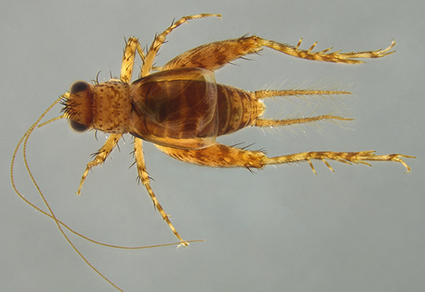Abstract
Hygronemobius Hebard, 1913 is a genus of nemobine crickets with a wide distribution in the Neotropical region, but also found in southern North America, typically inhabiting the leaf litter. They are small size crickets with the hind tibia bearing three dorsal spurs dorsally on each margin and three external and two internal apical spurs; male genitalia with a very broad ectophallic fold, forming a distinct ventral half-disc, with two ventrally directed pseudepiphallic lobes and a small dorsal cavity. Currently, 30 species are considered valid, of which nine are officially recorded in Brazil. Therefore, this work aims to describe two new species of Hygronemobius found in Brazil. The species were collected in the Melgaço and Juruti municipalities in Pará State. Additionally, Hygronemobius amoenus Chopard, 1920 and Hygronemobius nigrofasciatus Desutter-Grandollas, 1993 are being redescribed, and their distribution expanded to Brazil. Finally, Hygronemobius ottei n. nom. is proposed as a new name for Hygronemobius elegans (Otte, 2006) (Costa Rica) as it is a homonym of Hygronemobius elegans Desutter-Grandcolas, 1993 (Peru).
References
- Barranco, P., Gilgado, J.D. & Ortuño, V.M. (2013) A new mute species of the genus Nemobius Serville (Orthoptera, Gryllidae, Nemobiinae) discovered in colluvial, stony debris in the Iberian Peninsula: A biological, phenological and biometric study. Zootaxa, 3691 (2), 201–219. https://doi.org/10.11646/zootaxa.3691.2.1
- Chopard, L. (1920a) Diagnose d’une espèce nouvelle du genre Hygronemobius Heb. [Orth. Gryllidae]. Bulletin de la Société entomologique de France, 25, 120–122. https://doi.org/10.3406/bsef.1920.26599
- Chopard, L. (1967) Gryllides. Fam. Gryllidae: Subfam. Gryllinae (Trib. Gymnogryllini, Gryllini, Gryllomorphini, Nemobiini). In: Beier, M. (Ed.), Orthopterorum Catalogus. Dr. W. Junk B. V. Publishers, The Hague, pp. 499.
- Chopard, M.L. (1920b) Diagnoses de Gryllides [Orthoptères] nouveaux, de la Guyane Française, recueillis par M.R. Benoist. Société Entomologique de France, 26, 310–315.
- Cigliano, M.M., Braun, H., Eades, D.C. & Otte, D. (2025) Orthoptera Species File. Available from: https://orthoptera.speciesfile.org/ (accessed 25 January 2025)
- Desutter-Grandcolas, L. (1993) New Nemobiine Crickets from Guianese and Peruvian Amazonia (Orthoptera, Grylloidea, Trigonidiidae). Studies on Neotropical Fauna and Environment, 28, 1–37. https://doi.org/10.1080/01650529309360885
- Desutter-Grandcolas, L. (2003) Phylogeny and the evolution of acoustic communication in extant Ensifera (Insecta, Orthoptera). Zoologica Scripta, 32, 525–561. https://doi.org/10.1046/j.1463-6409.2003.00142.x
- Desutter-Grandcolas, L. & Hugel, S. (2016) First occurrence of Nemobiinae crickets in the Lesser Antilles (Orthoptera, Grylloidea, Trigonidiidae), with the descriptions of three new species. Zootaxa, 4168 (2), 313–326. https://doi.org/10.11646/zootaxa.4168.2.5
- Desutter, L. (1987) Structure et évolution du complexe phallique des Gryllidea (Orthoptera) et classification des genres Nétropicaux de Grylloidea, Première Partie. Annales de la Société Entomologique de France, New Series, 23, 213–239. https://doi.org/10.1080/21686351.1987.12278443
- Hebard, M. (1913) A new North American genus belonging to the group Nemobiites (Orthoptera, Gryllidae). Entomological News, 24, 451–452.
- Josse, H., Faberon, L., Schubnel, T., Nel, A. & Desutter-Grandcolas, L. (2023) Reconciliation between neontology and paleontology in the Gryllidea (Orthoptera, Ensifera): reinterpreting the venation of the stridulatory apparatus in crickets. Zoosystema, 45, 769–801. https://doi.org/10.5252/zoosystema2023v45a24
- de Martins, L.P., Pereira, M.R., Henriques, A.L. & Zefa, E. (2014) Two new species of Hygronemobius Hebard, 1913 (Orthoptera, Grylloidea, Nemobiinae) from Brazilian Amazon. Zootaxa, 3794 (3), 469–480. https://doi.org/10.11646/zootaxa.3794.3.8
- Otte, D. (2006) Eighty-four new cricket species (Orthoptera: Grylloidea) from La Selva, Costa Rica. Transactions of the American Entomological Society, 132, 299–418. https://doi.org/10.3157/0002-8320(2006)132[299:ENCSOG]2.0.CO;2
- Pereira, M.R., Miyoshi, A.R., Martins, L. de P., Fernandes, M.L., Sperber, C.F. & Mesa, A. (2013) New Neotropical species of Hygronemobius Hebard, 1913 (Orthoptera: Grylloidea: Nemobiinae), including a brief discussion of male genitalia morphology and preliminary biogeographic considerations of the genus. Zootaxa, 3641 (1), 1–20. https://doi.org/10.11646/zootaxa.3641.1.1
- Saussure, H. (1877) Mélanges orthoptérologiques. Vme Fascicule. Gryllides. Mémoires de la Société de Physique et d’Histoire Naturelle de Genève, 25, 169–504.
- de Saussure, H. (1874) Etudes sur les insectes orthoptères, famille des gryllides. In: Mission scientifique au Méxique et dans l’Amérique centrale. Imprimerie Impériale, Paris, pp. 296–515.
- Walker, F. (1869) Catalogue of the specimens of Dermaptera Saltatoria and supplement of the Blattari in the collection of the British Museum. Printed for the Trustees of the British Museum, London, 224 pp. [Gray, J.E. (Ed.), https://www.biodiversitylibrary.org/bibliography/8149]


